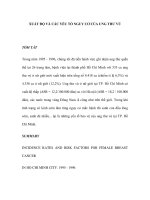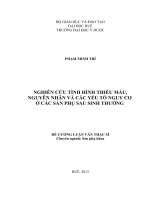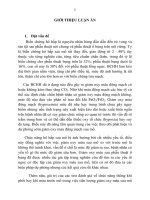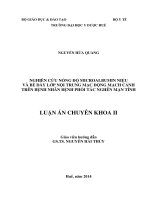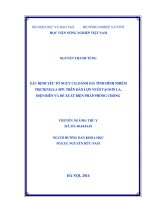TÍNH đa HÌNH của GENE THỤ THỂ PHOSPHOLIPASE a2 ẢNH HƯỞNG đến CHỨC NĂNG và là yếu tố NGUY cơ của GIA TĂNG độ dày lớp nội TRUNG mạc ĐỘNG MẠCH CẢNH
Bạn đang xem bản rút gọn của tài liệu. Xem và tải ngay bản đầy đủ của tài liệu tại đây (99.06 KB, 1 trang )
TÍNH ĐA HÌNH CỦA GENE THỤ THỂ PHOSPHOLIPASE A2 ẢNH
HƯỞNG ĐẾN CHỨC NĂNG VÀ LÀ YẾU TỐ NGUY CƠ CỦA GIA TĂNG
ĐỘ DÀY LỚP NỘI-TRUNG MẠC ĐỘNG MẠCH CẢNH
Nguyễn Văn Sĩ*, Kiyotaka Kugiyama#
TÓM TẮT
Mục tiêu: Thụ thể phospholipase A2 (PLA2R) có nhiều chức năng sinh học ngoài việc là thụ thể cho
men phospholipase A2. Nghiên cứu này khảo sát hai đột biến có ảnh hưởng đến chức năng của PLA2R ở
dòng tế bào và xác định mối liên quan với biểu hiện lâm sàng.
Phương pháp nghiên cứu: Khảo sát tế bào và nghiên cứu bệnh chứng.
Kết quả: Hai đột biến đa hình (T/C ở vị trí rs3749117 và G/C ở vị trí rs35771982) của gene PLA2R
xuất hiện đồng thời. Chúng tôi tạo ra dòng tế bào HEK293 biểu hiện PLA2R bình thường và PLA2R đột
biến. Tế bào HEK293 biểu hiện PLA2R đột biến có mức di chuyển và tăng sinh đáp ứng với collagen I
thấp hơn tế bào mang gene không đột biến. Ở 580 bệnh nhân nam giới, tính đa hình của gene PLA2R có
liên quan đến gia tăng độ dày tối đa lớp nội-trung mạc (maxIMT) động mạch cảnh. Hồi quy đa biến cho
thấy tính đa hình của PLA2R là một yếu tố nguy cơ của gia tăng maxIMT, độc lập với các yếu tố nguy cơ
tim mạch thường quy (OR = 1,93; 95% CI: 1,17-3,19; p < 0.01)
Kết luận: Đột biến đa hình của gene PLA2R ảnh hưởng đến hoạt động chức năng sinh học. Tính đa
hình của gene PLA2R là một yếu tố nguy cơ di truyền của gia tăng maxIMT động mạch cảnh ở nam giới.
Sự thay đổi về chức năng của gene PLA2R có thể đóng vai trò trong mối liên quan này.
Từ khóa: Tính đa hình của gene, thụ thể phospholipase A2, động mạch cảnh, xơ vữa động mạch.
ABSTRACT
POLYMORPHISMS OF PHOSPHOLIPASE A2
RECEPTOR GENE ALTER ITS
FUNCTIONS AND PRESENT A GENETIC RISK FOR AN INCREASE IN
INTIMA-MEDIA THICKNESS OF THE CAROTID ARTERY
Nguyễn Văn Sĩ, Kiyotaka Kugiyama
Aim: Phospholipase A2 receptor 1 (PLA2R) has multiple biological functions beyond a receptor for
secretory PLA2s.This study examined whether the same polymorphisms of PLA2R might alter functions of
PLA2R in cells expressing the variant PLA2R.And, the clinical relevance of the experiment was examined.
Method: Cross-sectional descriptive study and cell line investigation.
Results: Two nonsynonymous polymorphisms (T/C at rs3749117and G/C at rs35771982) in the
CTLD1 of PLA2R gene were completely linked. We produced HEK293 cells expressing human wild-type
PLA2R (T at rs3749117 and G at rs35771982) or human mutant PLA2R that had double mutations (C at
rs3749117 and C at rs35771982). HEK293 cells expressing mutant PLA2R had lower migratory and
proliferative responses to collagen I compared with cells expressing wild-type PLA2R. In 580 male
patients, the polymorphisms of PLA2R gene were associated with an increase in maximum intima-media
thickness (maxIMT) of the carotid artery. The multivariate regression model showed that the
polymorphisms of PLA2R were a risk factor for an increased maxIMT that was independent of
conventional risk factors (OR = 1.93, 95%CI: 1.17-3.19, p < 0.01).
Conclusion: The nonsynonymous common variants of PLA2R gene altered biological functions in
cells expressing variant PLA2R. The polymorphisms of PLA2R gene present a genetic risk for an
increased IMT of the carotid artery in male. The functional changes in the variant PLA2R may be possibly
responsible for its association with an increased IMT of the carotid artery.
Key words: gene polymorphism, phospholipase A2 receptor, carotid artery, atherosclerosis.

